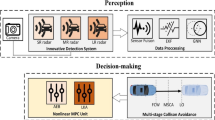Abstract. A system for hybrid adaptive cruise control (HACC) on high-speed roads designed as a combination of a radar-based ACC and visual perception is presented. The system is conceived to run on different performance levels depending on the actual perception capabilities. The advantages of a combination of the two different types of sensors are discussed in comparison to the shortcomings of each single sensor. A description of the visual lane detection and tracking procedure is given, followed by an overview of the vehicle detection, hypothesis generation, and tracking procedure. Enhanced robustness is achieved by cooperative estimation of egomotion and the dynamics of other vehicles using the lane-coordinate system as a common reference. Afterwards, the assignment of vehicles to lanes and the determination of the relevant vehicle for the longitudinal controller is described.
Similar content being viewed by others
Author information
Authors and Affiliations
Rights and permissions
About this article
Cite this article
Hofmann, U., Rieder, A. & Dickmanns, E. Radar and vision data fusion for hybrid adaptive cruise control on highways. Machine Vision and Applications 14, 42–49 (2003). https://doi.org/10.1007/s00138-002-0093-y
Issue Date:
DOI: https://doi.org/10.1007/s00138-002-0093-y




